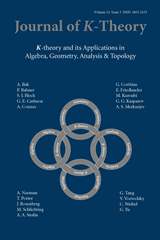No CrossRef data available.
Article contents
Quillen model categories
Published online by Cambridge University Press: 04 March 2013
Abstract
We provide a brief description of the mathematics that led to Daniel Quillen's introduction of model categories, a summary of his seminal work “Homotopical algebra”, and a brief description of some of the developments in the field since.
Keywords
- Type
- Research Article
- Information
- Copyright
- Copyright © ISOPP 2013
References
Ada74.F. Adams, J., Stable homotopy and generalised homology, University of Chicago Press, Chicago, Ill., Lectures in Mathematics, Chicago, 1974.Google Scholar
BF78.K. Bousfield, A. and Friedlander, E. M., Homotopy theory of γ-spaces, spectra, and bisimplicial sets, Geometric applications of homotopy theory (Proc. Conf., Evanston, Ill., 1977), II, Springer, Berlin, 1978, pp. 80–130.Google Scholar
BK72.K. Bousfield, A. and Kan, D. M., Homotopy limits, completions and localizations, Lecture Notes in Mathematics 304, Springer-Verlag, Berlin, 1972.Google Scholar
Bro73.Brown, Kenneth S., Abstract homotopy theory and generalized sheaf cohomology, Trans. Amer. Math. Soc. 186 (1973), 419–458.Google Scholar
BV73.Boardman, J. M. and Vogt, R. M., Homotopy invariant algebraic structures on topological spaces, Lecture Notes in Mathematics 347, Springer-Verlag, Berlin, 1973.Google Scholar
DHKS04.Dwyer, William G., Hirschhorn, Philip S., Kan, Daniel M., and Smith, Jeffrey H., Homotopy limit functors on model categories and homotopical categories, Mathematical Surveys and Monographs 113, American Mathematical Society, Providence, RI, 2004.Google Scholar
DK80.Dwyer, W. G. and Kan, D. M., Function complexes in homotopical algebra, Topology 19(4) (1980), 427–440.Google Scholar
EKMM97.Elmendorf, A. D., Kriz, I., Mandell, M. A., and May, J. P., Rings, modules, and algebras in stable homotopy theory, American Mathematical Society, Providence, RI, 1997, With an appendix by Cole, M..Google Scholar
EZ50.Eilenberg, Samuel and Zilber, J. A., Semi-simplicial complexes and singular homology, Ann. of Math. (2)51 (1950), 499–513.CrossRefGoogle Scholar
GJ99.Goerss, Paul G. and Jardine, John F., Simplicial homotopy theory, Progress in Mathematics 174, Birkhäuser Verlag, Basel, 1999.Google Scholar
GZ67.Gabriel, P. and Zisman, M., Calculus of fractions and homotopy theory, Ergebnisse der Mathematik und ihrer Grenzgebiete 35, Springer-Verlag New York, Inc., New York, 1967.Google Scholar
Har66.Hartshorne, Robin, Residues and duality, Lecture notes of a seminar on the work of A. Grothendieck, given at Harvard 1963/64. With an appendix by Deligne, P.. Lecture Notes in Mathematics 20, Springer-Verlag, Berlin, 1966.Google Scholar
Hir03.Hirschhorn, Philip S., Model categories and their localizations, Mathematical Surveys and Monographs 99, American Mathematical Society, Providence, RI, 2003.Google Scholar
Hov99.Hovey, Mark, Model categories, American Mathematical Society, Providence, RI, 1999.Google Scholar
Hov01.Hovey, Mark, Spectra and symmetric spectra in general model categories, J. Pure Appl. Algebra 165 (1) (2001), 63–127.CrossRefGoogle Scholar
HSS00.Hovey, Mark, Shipley, Brooke, and Smith, Jeff, Symmetric spectra, J. Amer. Math. Soc. 13 (1) (2000), 149–208.Google Scholar
Joy02.Joyal, A., Quasi-categories and Kan complexes, J. Pure Appl. Algebra 175 (1-3) (2002), 207–222, Special volume celebrating the 70th birthday of Professor Max Kelly.CrossRefGoogle Scholar
Kan56.Kan, Daniel M., Abstract homotopy. III, Proc. Nat. Acad. Sci. U.S.A. 42 (1956), 419–421.Google Scholar
Lur09.Lurie, Jacob, Higher topos theory, Annals of Mathematics Studies 170, Princeton University Press, Princeton, NJ, 2009.Google Scholar
May92.May, J. Peter, Simplicial objects in algebraic topology, Chicago Lectures in Mathematics, University of Chicago Press, Chicago, IL, 1992, Reprint of the 1967 original, also available at http://www.math.uchicago.edu/∼may/.Google Scholar
Mil57.Milnor, John, The geometric realization of a semi-simplicial complex, Ann. of Math. (2) 65 (1957), 357–362.Google Scholar
MMSS01.Mandell, M. A., May, J. P., Schwede, S., and Shipley, B., Model categories of diagram spectra, Proc. London Math. Soc. (3) 82 (2) (2001), 441–512.Google Scholar
Moo58.Moore, John C., Semi-simplicial complexes and Postnikov systems, Symposium internacional de topología algebraica International symposium on algebraic topology, Universidad Nacional Autónoma de México and UNESCO, Mexico City, 1958, pp. 232–247.Google Scholar
MV99.Morel, Fabien and Voevodsky, Vladimir, A1-homotopy theory of schemes, Inst. Hautes Études Sci. Publ. Math. (1999), no. 90, 45–143 (2001).Google Scholar
Qui64.Quillen, Daniel, Formal properties of over-determined systems of linear partial differential equations, Ph.D. thesis, Harvard University, 1964.Google Scholar
Qui67.Quillen, Daniel G., Homotopical algebra, Lecture Notes in Mathematics 43, Springer-Verlag, Berlin, 1967.Google Scholar
Ree74.Reedy, Christopher Leonard, Homology of algebraic theories, ProQuest LLC, Ann Arbor, MI, 1974, Thesis (Ph.D.)–University of California, San Diego.Google Scholar
SS00.Schwede, Stefan and Shipley, Brooke E., Algebras and modules in monoidal model categories, Proc. London Math. Soc. (3) 80 (2) (2000), 491–511.Google Scholar
Voe03.Voevodsky, Vladimir, Motivic cohomology with Z/2-coefficients, Publ. Math. Inst. Hautes Études Sci. 98 (2003), 59–104.Google Scholar
Vog70.Vogt, Rainer, Boardman's stable homotopy category, Matematisk Institut, Aarhus Universitet, Lecture Notes Series 21, Aarhus, 1970.Google Scholar
Wei01.Weibel, Charles, Homotopy ends and Thomason model categories, Selecta Math. (N.S.) 7 (4) (2001), 533–564.Google Scholar




